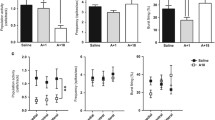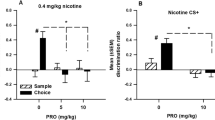Abstract
Latent inhibition (LI) is a cognitive process whereby repeated exposure of a stimulus without consequence impedes the formation of subsequent associations with that stimulus. A number of studies in the rat have reported that LI is impaired by moderate systemic doses of amphetamine, an effect believed to be mediated via dopamine (DA) release in the nucleus accumbens. We and others have reported that nicotine has a selective effect in releasing DA in the accumbens rather than the caudate nucleus. We have therefore examined the ability of nicotine to disrupt LI, using a conditioned emotional response paradigm. Pre-exposure of a tone stimulus impaired subsequent conditioning between that stimulus and mild footshock, as indexed by suppression of licking by the tone subsequently presented alone. This LI effect was prevented, by an effect confined to the pre-exposed group, by doses of 0.4 or 0.6 mg/kg nicotine SC, which are accumbens selective, given before pre-exposure and before conditioning. The effect of nicotine in disrupting LI was prevented by prior administration of haloperidol at a dose (0.5 mg/kg) reported to reverse the disruptive effect of amphetamine on LI. Although the amphetamine effect requires two administrations, the effect of two administrations of nicotine was reproduced by a single dose of nicotine given before conditioning, but not by a single dose before pre-exposure. The results are discussed in relation to studies in human control and schizophrenic subjects, which suggest that increased DA activity in humans is also associated with impaired LI. The results indicate that nicotine does indeed increase functional DA activity in the rat accumbens; the consequent disruption of LI critically depends upon an action at the time of conditioning, and is independent of processes which occur during pre-exposure. In more general terms, this indicates the potential of drug experiments to complement behavioural studies on the mechanism of latent inhibition.
Similar content being viewed by others
References
Balfour DJK (1982) The effects of nicotine on brain neurotransmitter systems. Pharmacol Ther 16:269–282
Baruch I, Hemsley DR, Gray JA (1988) Differential performance of acute and chronic schizophrenics in a latent inhibition task. J Nerv Ment Dis 176:598–606
Brazell MP, Mitchell SN, Joseph MH, Gray JA (1990) Acute administration of nicotine increases the in vivo extracellular levels of dopamine, DOPAC and ascorbic acid preferentially in the nucleus accumbens of the rat: comparison with caudateputamen. Neuropharmacology 29:177–185
Cassaday HJ, Hodges H, Gray JA (1991) The effects of pharmacological and neurotoxic manipulation of serotonergic activity on latent inhibition in the rat: implications for the neural basis of acute schizophrenia. In: Cassano GB, Akiskal HS (eds) Serotonin related psychiatric syndromes: clinical and therapeutic links. Royal Society of Medicine Services, London, pp 99–105
Christison GW, Atwater GE, Dunn LA, Kilts CD (1988) Haloperidol enhancement of latent inhibition: relation to therapeutic action. Biol Psychiatry 23:746–749
Clarke PBS (1990) The central pharmacology of nicotine: electrophysiological approaches. In: Wonnacott S, Russell MAH, Stolerman IP (eds) Nicotine psychopharmacology. Oxford University Press, Oxford, pp 194–225
Erechefsky L, Jann MW, Saklad SR, Davis CM, Richards AL, Burch NR (1985) Effects of smoking on fluphenazine clearance in psychiatric inpatients. Biol Psychiatry 20:329–332
Feldon J, Weiner I (1991) The latent inhibition model of schizophrenic attention disorder; haloperidol and sulpiride enhance rats' ability to ignore irrelevant stimuli. Biol Psychiatry 29:635–646
Fuxe K, Andersson K, Harfstrand A, Eneroth P, Perez de la Mora M, Agnati L (1990) Effects of nicotine on synaptic transmission in the brain. In: Wonnacott S, Russell MAH, Stolerman IP (eds) Nicotine psychopharmacology. Oxford University Press, Oxford, pp 194–225
Gray NS, Hemsley DR & Gray JA (1992a) Abolition of latent inhibition in acute but not chronic schizophrenics. Neurol Psychiatry Brain Res (in press)
Gray NS, Pickering AD, Hemsley DR, Dawling S, Gray JA (1992b) Abolition of latent inhibition by a single 5 mg dose ofd-amphetamine in man. Psychopharmacology 107:425–430
Hellman, PA, Crider A, Solomon PR (1983) Interaction of tailpressure stress andd-amphetamine in disruption of the rat's ability to ignore an irrelevant stimulus. Behav Neurosci 97:1017–1021
Hughes JR, Hatsukami DK, Mitchell JE, Dahlgren LA (1986) Prevalence of smoking among psychiatric outpatients. Am J Psychiatry 143:993–997
Imperato A, Mulas A, Di Chiara G (1986) Nicotine preferentially stimulates dopamine release in the limbic system of freely moving rats. Eur J Pharmacol 132:337–338
Jann MW, Saklad SR, Erechefsky L, Richards AL, Harrington CA, Davis CM (1986) Effects of smoking on haloperidol and reduced haloperidol plasma concentrations and haloperidol clearance. Psychopharmacology 90:468–470
Lubow RE (1989) Latent inhibition and conditioned attention theory. Cambridge University Press, Cambridge, UK
Menza MA, Grossman N, Van Horn M, Cody R, Forman N (1991) Smoking and movement disorders in psychiatric patients. Biol Psychiatry 30:109–115
Mitchell SN, Brazell MP, Joseph MH, Alivijeh MS, Gray JA (1989) Regionally specific effects of acute and chronic nicotine on rates of catecholamine and indolemaine synthesis in rat brain. Eur J Pharmacol 167:311–322
Mitchell SN, Smith KM, Joseph MH, Gray JA (1992) Acute and chronic effects of nicotine on catecholamine sythesis and release in the rat central nervous system. In: Lipiello PM, Collins AC, Gray JA, Robinson JH (eds) The biology of nicotine; current research issues. Raven Press, New York, pp 97–119
O'Neill MF, Dourish CT, Iversen SD (1991) Evidence for an involvement of D1 and D2 dopamine receptors in mediating nicotine-induced hyperactivity in rats. Psychopharmacology 104:343–350
Peters SL, Gray JA, Joseph MH (1992) Nicotine blocks latent inhibition in rats: evidence for increased functional activity of dopamine in the mesolimbic system. J Psychopharmacol 6:110
Solomon PR, Staton DM, (1982) Differential effects of micro-injections ofd-amphetamine into the nucleus accumbens or the caudate-putamen on the rat's ability to ignore an irrelevant stimulus. Biol Psychiatry 17:743–756
Solomon PR, Crider A, Winkelman JW, Turi A, Kamer RM, Kaplan LJ (1981) Disrupted latent inhibition in the rat with chronic amphetamine or haloperidol-induced supersensitivity: relationship to schizophrenic attention disorder. Biol Psychiatry 16:519–537
Vinarova E, Vinar O, Kalvach Z (1984) Smokers need higher doses of neuroleptic drugs. Biol Psychiatry 18:1265–1268
Warburton EC, Feldon J, Weiner I, Gray JA, Joseph MH (1992) Antagonism of low dose amphetamine disruption of latent inhibition in rats by haloperidol, and by the 5HT-3 antagonist, ondansetron. J Psychopharmacol 6:110
Weiner I (1990) Neural substrates of latent inhibition: the switching model. Psychol Bull 108:442–461
Weiner I, Lubow RE, Feldon J (1984) Abolition of the expression but not the acquisition of latent inhibition by chronic amphetamine in rats. Psychopharmacology 83:194–199
Weiner I, Feldon J, Katz Y (1987a) Facilitation of the expression but not the acquisition of latent inhibition by haloperidol in rats. Pharmacol Biochem Behav 26:241–246
Weiner I, Israeli-Telerent A, Feldon J (1987b) Latent inhibition is not affected by acute or chronic administration of 6 mg/kgdl-amphetamine. Psychopharmacology 91:345–351
Weiner I, Lubow RE, Feldon J (1988) Disruption of latent inhibition by acute administration of low doses of amphetamine in rats. Pharmacol Biochem Behav 30:871–878
Weiner I, Shofel A, Feldon J (1990) Disruption of latent inhibition by low dose of amphetamine is antagonised by haloperidol and apomorphine. J Psychopharmacol 4:255
Author information
Authors and Affiliations
Rights and permissions
About this article
Cite this article
Joseph, M.H., Peters, S.L. & Gray, J.A. Nicotine blocks latent inhibition in rats: evidence for a critical role of increased functional activity of dopamine in the mesolimbic system at conditioning rather than pre-exposure. Psychopharmacology 110, 187–192 (1993). https://doi.org/10.1007/BF02246971
Received:
Revised:
Issue Date:
DOI: https://doi.org/10.1007/BF02246971




